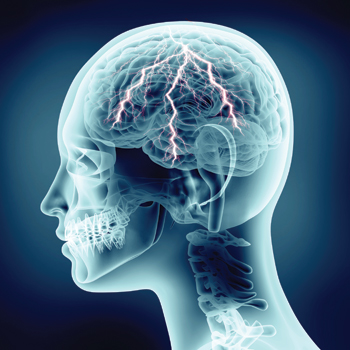Headaches that should flag further attention
Every patient with a headache needs to have secondary causes ruled out, and the acronym SNOOP4 is easy to adopt and use.
When is a headache not a migraine? When it's waving a red flag that it might be secondary to some other condition, according to Amaal J. Starling, MD.
Dr. Starling, an assistant professor of neurology at Mayo Clinic in Scottsdale, reviewed these red flags and some urgent causes of headache during the Mayo Clinic Hospital Medicine 2017 conference, held in Tucson, Ariz., in November.
“Your first responsibility when you see that patient with a headache is to rule out secondary causes,” said Dr. Starling. “Every headache patient that you see, you need to have a systematic approach.”

She recommends an approach called SNOOP4. “I love mnemonics, and SNOOP4 is one of my favorite ones, developed by my mentor, Dr. David Dodick. I've adapted it a little bit,” she said.
As Dr. Starling explained, S is for systemic symptoms, such as fevers, chills, and weight loss or gain. N is for neurologic symptoms and signs, “specifically focal ones, such as unilateral weakness, paralysis, numbness, visual loss, difficulty with thinking skills such as making mistakes at work,” she said. The first O is for older age at onset (over 50 is a red flag), and the second is for sudden onset of this specific headache attack.
“A headache that reaches peak intensity, 10 out of 10 pain, in less than a minute—that is a neurologic emergency and definitely something we need to elicit in history,” said Dr. Starling. Then there are the four P's: precipitation with Valsalva maneuver or exertion, postural or positional, pattern change or progressive, and pregnancy.
Causes of secondary headaches
Dr. Starling offered examples of headache causes that could be identified, or at least suspected, using the SNOOP4 mnemonic, including giant-cell arteritis (GCA). “This occurs typically in older individuals, in white females,” she said. “This is high on my differential for anyone with a new-onset headache greater than the age of 50.”
Headaches caused by GCA can also be red-flagged by the presence of systemic symptoms. About half of the time, patients with GCA have polymyalgia rheumatica or jaw and tongue claudication. Scalp tenderness is another symptom.
“People might have an abnormal temporal artery exam, where there's some nodularity, it's tender to the touch, or there may actually be absent temporal pulsations,” added Dr. Starling. Visual symptoms can include double, blurred, or darkened vision and “of course the irreversible complication of ischemic optic neuropathy, which presents with vision loss, and that's what we're trying to prevent,” she said.
If a patient presents with these symptoms, the first step is not diagnosis, it's treatment. “Because we are trying to prevent that feared complication of visual loss, when you suspect it, treat it. Do not allow for diagnostic workup and confirmation to delay your initiation of high-dose corticosteroids,” said Dr. Starling. She recommended a dose of 1 mg/kg of prednisone with an upper limit of 60 mg/d. Some studies have also found benefit from low-dose aspirin (81 mg) to prevent cranial ischemic complications, she noted.
Once steroids are prescribed, the workup for GCA should include an erythrocyte sedimentation rate (ESR), complete blood count (CBC), and C-reactive protein (CRP) level. “It's important to include a CBC and specifically a CRP because up to a quarter of individuals with biopsy-confirmed GCA may actually have a normal ESR, so the CRP is actually a more sensitive inflammatory marker for GCA,” said Dr. Starling.
Patients with suspected GCA should also undergo a temporal artery biopsy within seven days of initiating steroids, she advised. “And remember, even though they start with the symptomatic side, make sure that whoever performs the biopsy also performs bilateral biopsies if the symptomatic side is negative. Due to skip lesions, the vasculitis isn't continuous.”
Because patients with GCA frequently also have large vascular involvement, angiography of the chest by magnetic resonance or CT or positron emission tomography is needed. “This is important, specifically for follow-up, because individuals that have that large-vessel involvement, they need an annual screening chest X-ray or a transthoracic echocardiogram, because one out of five individuals with large-vessel involvement in GCA end up with an aortic aneurysm, and one out of 16 end up with a dissection,” said Dr. Starling.
Thunderclap headache
If the headache red flag is sudden onset, a different diagnostic algorithm is in order. “What are 10 things that cause thunderclap headache?” Dr. Starling asked. “Subarachnoid hemorrhage. Great! Next? Subarachnoid hemorrhage. … That is the first thing that you should think about; that is all the way down to the tenth thing that you should think about.”
To diagnose a subarachnoid hemorrhage, order a CT scan of the head without contrast and a lumbar puncture. “The reason that you want to do both is because there is this inverse timing relationship between the CT head and the lumbar puncture, depending on when the subarachnoid hemorrhage occurred and when the person presented,” she said. “Within the first 24 hours, a CT head is highly sensitive, after which it loses sensitivity. … In the intial six hours after the thunderclap headache, the lumbar puncture is not as sensitive; however, the lumbar puncture beyond 12 hours and at one week and two weeks is really 100% sensitive.”
If the results of both tests are normal, the good news is the patient probably doesn't have a subarachnoid hemorrhage. Unfortunately, there are a lot of other etiologies of a thunderclap headache. “And they are neurologic emergencies,” said Dr. Starling, who divided the potential headache causes into vascular and nonvascular.
“In the vascular column, the one that we very commonly see and is oftentimes missed is reversible cerebral vasoconstriction syndrome and then also hypertensive crisis, cervical artery dissection, as well as cerebral venous thrombosis and stroke,” she said. Potential nonvascular causes include meningitis, sinusitis (especially sphenoid), and spontaneous intracranial hypotension.
“You need to do neurovascular imaging so that you can rule out all the different vascular and nonvascular causes,” Dr. Starling said. This can include MRI, magnetic resonance angiography (MRA), magnetic resonance venography (MRV), or CT angiography or venography scans if the other tests are not immediately available.
Those scans can reveal vascular patterns such as “beads on a string,” which indicate reversible cerebral vasoconstriction syndrome (RCVS). The first step in treatment of RCVS is to withdraw any serotonergic medications, Dr. Starling advised. “Also elicit a history of any drug abuse, because marijuana and cocaine can be associated with RCVS,” she said.
Patients should be treated with a calcium-channel blocker. “Borrowing from the subarachnoid hemorrhage literature and evidence, we use nimodipine, which isn't actually FDA-approved for the treatment of RCVS, but we haven't actually performed any [randomized controlled trials] in the treatment of RCVS,” she said.
The tricky part is making sure that patients don't become hypotensive. “So you want to run IV fluids at the same time you're also giving them the IV calcium-channel blocker,” said Dr. Starling. Another pitfall to avoid is steroid treatment, which has been associated with worse outcomes from RCVS.
“There is another entity that has this exact same imaging and that's CNS [central nervous system] vasculitis. … In CNS vasculitis, the treatment initially is with corticosteroids,” said Dr. Starling. To differentiate the two, pay attention to patients' reported symptoms. “RCVS—thunderclap-onset headache for clinical presentation. CNS vasculitis—the headache is going to be diffuse, subacute, insidious, progressive headache.”
The two conditions can also be distinguished by the results of a lumbar puncture. “If you perform a lumbar puncture in RCVS, 90% of the time it will be completely normal. In CNS vasculitis, it will be an inflammatory picture, 90% of the time,” she said.
When not to puncture
A lumbar puncture is a good diagnostic tool for some causes of headache, but for others, it can make the situation worse. Dr. Starling offered the case of one patient who had a progressive daily headache that got worse throughout the day and with coughing, yelling, or stress.
The patient turned out to have spontaneous intracranial hypotension, so ordering a lumbar puncture would not have been good. “They already have less spinal fluid than they should, and then you're going to puncture their thecal sac and take out more spinal fluid and that actually makes the whole situation worse. Sometimes patients can actually decompensate if that does occur,” she said.
Instead, the best diagnostic tools would be an MRI of the brain with and without contrast and an MRI of the spine without contrast. She also recommended seeking a consult with a neurologist due to the complicated diagnostic and treatment algorithm.
Her final red-flag headache example also highlighted the importance of collaboration between the specialties. Pregnancy is associated with secondary headaches, especially in women with a history of migraine.
“Migraine patients who become pregnant are actually at higher risk for things like eclampsia or cerebral sinus venous thrombosis, likely related to endothelial dysfunction that occurs in people with migraine,” Dr. Starling said.
Diagnosis of course requires testing, but some standard modalities, including contrast, are contraindicated in pregnant women.
“Fortunately, there are some studies that we can do, especially in the second and third trimester of pregnancy, that are safe, including a noncontrast MRI of the brain, an MRA of the head, an MRV of the head, and a lumbar puncture,” said Dr. Starling. “The radiologist will just use time-of-flight imaging to see the blood vessels. … It can still be done, if you just talk to your radiologist.”





